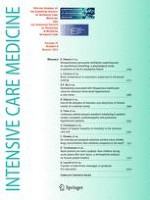Published in:

01-08-2011 | Review
Acquired hemophilia: a rare but life-threatening potential cause of bleeding in the intensive care unit
Authors:
Aryeh Shander, Christopher E. Walsh, Caroline Cromwell
Published in:
Intensive Care Medicine
|
Issue 8/2011
Login to get access
Abstract
Objective
There are a number of potential etiologies of severe bleeding encountered in the intensive care unit. Although rare, acquired hemophilia is one such etiology that often presents with major bleeding requiring intensive care. Despite the introduction of effective treatments, the reported mortality rate of patients with acquired hemophilia ranges from 6 to 8% and is in part attributable to sequential delays in diagnosis and appropriate treatment. The purpose of this review is to familiarize the intensive care specialist with this underrecognized cause of bleeding, with an emphasis on diagnosis and treatment.
Methods
As the objective of this article was to provide a concise overview of the diagnosis and management of acquired hemophilia, a directed search of English-language literature was undertaken using the PubMed database, targeting such topics as the differential diagnosis of bleeding in the intensive care unit and the epidemiology, diagnosis, and treatment of acquired hemophilia. Clinical study findings pertaining to the efficacy of specific treatments for acquired hemophilia were summarized.
Results and conclusion
Recognition of acquired hemophilia presents a clinical challenge, given the rarity of this condition, a general lack of familiarity with acquired hemophilia, and the potential for confusion with other more common causes of bleeding in the intensive care unit. Nevertheless, there are sentinel clinical and laboratory findings that should raise suspicion of this diagnosis. The treatment of acquired hemophilia is a multi-step, physiologically focused process aimed at controlling both active and recurrent bleeding. Therefore, prompt diagnosis is central to prognosis. Consultation with a hematologist may facilitate efficient diagnosis and management.